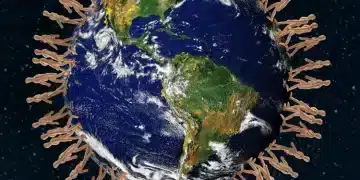Why Arctic’s Record-Breaking Ice Loss Threatens Global Climate Stability
Unprecedented Arctic Ice Loss: A New Record Low
The Arctic winter sea ice extent has plummeted to a record low, marking a critical alert in the 47 years of satellite monitoring.
Alarming new data reveals that this March, peak coverage reached only 5.53 million square miles.
To put that into perspective, we’ve lost an ice area equivalent to the entire state of South Carolina or the combined territories of California, Texas, and Washington.
This is a stark decline from the average recorded between 1981 and 2010 and highlights the accelerated impact of rising global temperatures.
Dwindling Sea Ice Signals Warming
Sea ice typically reaches its maximum in March after enduring months of polar darkness. However, the ice formed this year is 31,000 square miles less than the previous record minimum.
Such a significant reduction provides tangible proof of the alarming trends we’ve observed in recent decades.
These shrinking ice levels are symptomatic of the Arctic warming at an unprecedented rate—four times faster than any other region in the world.
Implications of Decreased Ice Coverage
The consequences of this record low sea ice are far-reaching.
Beyond signaling climate change, the lack of ice also exacerbates it.
Less ice means more exposed ocean surface, which absorbs over 90% of solar radiation.
This stark contrast to the ice’s natural ability to reflect over half of incoming solar radiation accelerates the warming and melting cycle, creating a detrimental feedback loop that can hasten the complete loss of summer sea ice.
This crisis underlines the urgency of addressing climate change to mitigate its rapid, adverse effects on our world.
The Arctic’s Accelerated Warming Crisis
The Arctic is warming four times faster than any other region on Earth, creating an urgent climate crisis.
This alarming rate of warming is compounded by the fact that temperatures in the Arctic have been recorded to be up to 22 degrees Fahrenheit above average.
This extreme temperature rise is reshaping the Arctic landscape with unprecedented speed and severity.
The Heat Trap
The accelerated warming in the Arctic is part of a dangerous feedback loop.
Reduced sea ice means more sunlight and heat are absorbed by the ocean, rather than being reflected back into space by the ice.
This absorption of solar radiation causes the temperature of the water to increase, which in turn hastens further ice melt—a cycle that becomes self-perpetuating.

Cataclysmic Consequences
The rapid warming of the Arctic has far-reaching implications.
As the region heats up and sea ice diminishes, the natural insulation it provides during winter months is compromised.
This not only affects local wildlife, which relies on the ice for hunting and breeding, but also exposes the coastline to severe erosion.
Some communities face slipping into the sea due to the relentless wave action on unprotected shores.
Moreover, these changes are not limited to the Arctic alone.
The loss of sea ice can have a global impact.
Studies suggest that a complete loss of summer sea ice in the Arctic would significantly elevate global temperatures, with effects comparable to adding a trillion tons of CO2 to the atmosphere.
The changes in the Arctic can also disturb the jet stream, leading to more extreme weather patterns across the globe.
The escalating crisis in the Arctic signals a profound shift in our planet’s climate system, one with lasting impacts that extend well beyond the polar regions.
Sea Ice’s Critical Role in Global Climate Regulation
Sea ice in the Arctic is more than just frozen water; it’s a vital part of Earth’s climate system.
By understanding its roles, we can appreciate why its loss is so worrisome.
Earth’s Natural Air Conditioning System
Sea ice acts as the planet’s air conditioner.
During the summer, when the sun shines constantly in the Arctic, sea ice reflects over 50% of the solar radiation that hits it.
This albedo effect is crucial as it helps to keep our planet cool.
Without it, the ocean beneath absorbs the heat, leading to a vicious cycle of warming and more ice melt.
Winter Insulation
During the winter, sea ice plays an equally important role.
The Arctic Ocean tends to be warmer than the surrounding air, and the ice acts as an insulating blanket, trapping the warmth in the water and preventing it from escaping into the atmosphere.
This natural insulation keeps temperatures more stable, both in the Arctic region and globally.
Reflecting Solar Radiation
The reflective nature of sea ice, known as its albedo, is one of its critical functions.
In summer months, the ice reflects about 50% of the solar radiation back into space.
Without this reflective shield, the dark ocean surface would absorb more than 90% of the radiation, escalating the melting process and leading to accelerated global warming.
Given these vital roles, the loss of Arctic sea ice is incredibly troubling.
With less ice, the Earth’s natural cooling ability weakens, making the planet more vulnerable to temperature spikes and extreme weather events.
The cascading effects are felt far beyond the Arctic, emphasizing the need for urgent climate action.
The Devastating Feedback Loop
Ice-Free Oceans and Solar Radiation
When the Arctic sea ice diminishes, the dynamics of solar radiation absorption drastically change.
Sea ice is highly reflective, bouncing more than 50% of the sun’s rays back into space.
In contrast, the dark, open ocean absorbs over 90% of incoming solar radiation.
This absorbed sunlight heats the water, causing the ocean temperature to rise and accelerating the melting of the remaining ice even further.
Accelerated Warming and Ice Melt
The increased absorption of solar radiation creates a severe feedback mechanism.
As temperatures rise, more ice melts, exposing even more dark ocean waters.
This, in turn, absorbs more sunlight, perpetuating a cycle of warming and melting.
Each year, the cycle strengthens, leading to progressively lower ice coverage.
This loop is key to understanding the Arctic’s rapid warming, which is occurring four times faster than the global average.
Broad Implications
This feedback loop has far-reaching consequences.
For instance, the loss of ice impacts the habitat of Arctic wildlife, such as polar bears and seals, which rely on stable ice platforms for hunting and breeding.
Moreover, the warming Arctic contributes to rising sea levels and increased erosion of coastlines, threatening communities both locally and globally.
As the ice continues to recede, the balance of the Earth’s climate regulation is further disrupted.
The escalating loss of sea ice not only exacerbates regional temperature increases but also impacts weather patterns worldwide.
The undeniable progression of this destructive cycle amplifies the urgency for global actions to mitigate climate change.
Global Implications and Future Threats
Potential Complete Loss of Summer Sea Ice
The rapid decline in Arctic sea ice has dire implications for our planet, extending well beyond the polar region.
Scientists predict that we could witness the complete loss of summer sea ice within the next few decades.
This isn’t just a local problem; it’s a global crisis.
Equivalent Impact to Adding a Trillion Tons of CO2
The disappearance of Arctic sea ice has a global warming potential equivalent to adding a trillion tons of CO2 to the atmosphere.
This is because ice reflects sunlight, helping to cool the planet.
When the ice melts, the dark ocean absorbs more heat, accelerating global warming.
The heat trapped could significantly elevate temperatures worldwide, compounding the effects of climate change.
Risks to Wildlife
The disappearance of summer sea ice spells disaster for Arctic wildlife.
Polar bears, seals, and other animals depend on sea ice for survival.
They use it to hunt, breed, and provide a stable platform for raising their young.
Without ice, their habitats and food sources will diminish, pushing these species toward extinction.
Threats to Coastal Communities
Arctic ice loss isn’t just an ecological issue; it’s also a socio-economic one.
As the ice melts, coastal communities are at risk.
The lack of ice exposes coastlines to intense wave action, accelerating erosion and threatening the livelihoods of people living in these areas.
Some communities might even need to relocate entirely due to rising sea levels and eroding land.
Disruption of Global Weather Patterns
The loss of Arctic ice can disrupt global weather patterns.
The Arctic influences major air currents, such as the jet stream, which affects weather systems worldwide.
Changes in the Arctic can lead to more extreme and unpredictable weather events, from harsher winters to more intense heatwaves and storms.
The ramifications of dwindling Arctic ice are vast, affecting everything from global temperatures to wildlife and human communities.
As the ice continues to recede, the urgency for comprehensive climate action grows.





